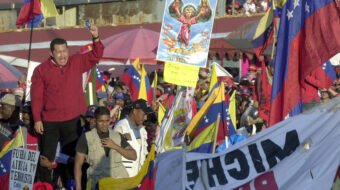
“How would you describe the School of the Americas?” Opera Mundi interviewer Giorgio Trucchi recently asked Father Roy Bourgeois, director of School of the Americas Watch. “As a school of assassins, torturers, and leaders of coups,” replied the Vietnam War veteran and Catholic priest who founded School of the Americas Watch in 1990.
Bourgeois continued: “They’ve trained more than 60,000 soldiers there, half of whom are Colombian. For more than 20 years we’ve monitored the trajectory of these graduates, and we’ve found hundreds of connections with the most serious atrocities committed in Latin America beginning with the military dictators of decades past. Besides, it’s a clear symbol of the foreign policy of my country.”
The U.S. government established SOA in Panama in 1946, moving the U.S. Army school to Ft. Benning, Ga., in 1984. For military personnel who are its students, SOA inculcates U.S.-style tactics and strategy, with attention to counter-insurgency capabilities. The school’s name was changed in 2000 to the “Western Hemisphere Institute for Security Cooperation,” but nothing more changed, says Bourgeois. A primary SOA goal is to cement tight personal relations amongst U.S. and Latin American military leaders, he asserts.
SOA Watch has brought public attention to dictators, military strongmen, and murderers who were SOA graduates. Until recently, the organization centered its campaign on closing down the school. Its emblematic action has been a vigil and protest held annually outside a Ft. Benning gate. Over 180 protesters have served jail time because of civil disobedience at the vigils. Because of his own anti-SOA actions, Father Bourgeois has spent four years in prison.
The vigil this year takes place in Columbus, Ga., November 17-18, with educational sessions beginning on November 16.
Reporter Trucchi asked: “How does SOA represent U.S. foreign policy?”
Bourgeois: “The United States is used to expanding in a continent it considers its own, and does it through extending its forces and influence in order to control any type of progressive or leftist movement in Latin America. SOA has always been part of this strategy. It’s no accident that attempted coups in Venezuela (2002), Honduras (2009), and Ecuador (2010) were led by SOA graduates.”
Trucchi: “Are there economic ties with interests in the region, beyond political and strategic ones?”
Bourgeois: “Of course, there are. The Pentagon says they teach democracy and defense of human rights there, which is absurd. The SOA role is still defense of U.S. economic interests and those of transnational corporations, in collusion with local oligarchs. Of course, the people are waking up. They are organizing and uniting and they are telling the empire that now it can’t come into these countries the way the conquistadors did, to exploit resources and peoples. There are already six countries – Venezuela, Bolivia, Argentina, Ecuador, Uruguay, and Nicaragua – that have said they aren’t going to send any more soldiers to Ft. Benning.”
Father Bourgeois’ evocation of imperial designs is matched by SOA Watch, broadening its agenda recently to take on U.S. militarization itself. That is not a far stretch from the group’s accustomed role of fighting U.S. preparation of criminal security forces.
International Law Enforcement Academies operated by the U.S. government are now located in Peru and El Salvador – and in Hungary, Thailand, and Botswana. This year a seaside U.S. training facility for urban warfare took root under U.S. Southern Command auspices in Concón, Chile. In 2011, a Ft. Bragg Special Forces contingent arrived unannounced in Buenos Aires, Argentina, ready to train local police. The U.S. government is backing Colombian military and police trainers working in Mexico, Honduras, and Paraguay.
Roy Bourgeois’ view that SOA serves imperial purposes takes on added credibility with news that a SOA replica is operating in Iraq, a region newly prepared for exploitation. On June 17, 2012, the U.S. Embassy in Baghdad celebrated the opening of the Al-Nahrain Center for Strategic Studies. A press release explained: “The center, which includes Iraq’s National Defense University and National Defense College, the Iraq War College, and the Iraq Language Institute, will facilitate regional dialogue and serve as a basis for partnership building between Iraq and other nations throughout the region.” The U.S. government paid $15 million to build the facilities.
For New York University Professor Sinan Antoon, writing for the independent Jadaliyya website, this was not good news: “The language in the press release and the code words (military training, strategic and regional cooperation) are reminiscent of the discourse and practices of the notorious School of the Americas. In fact, he warns, it’s the “Baghdad Campus of the School of the Americas.”
Photo: Al Viola/SOA Watch Facebook

MOST POPULAR TODAY

High Court essentially bans demonstrations, freedom of assembly in Deep South

Zionist organizations leading campaign to stop ceasefire resolutions in D.C. area

U.S. imperialism’s ‘ironclad’ support for Israel increases fascist danger at home


UN warns that Israel is still blocking humanitarian aid to Gaza






Comments